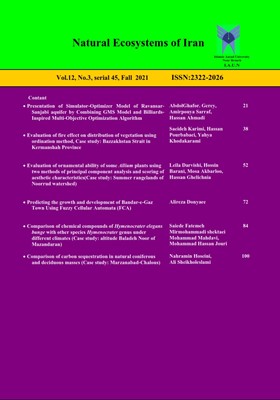Evaluation of fire effect on distribution of vegetation using ordination method, Case study: Bazzakhstan Strait in Kermanshah Province
Subject Areas : FOREST ecologysaeideh karimi 1 , Hassan Pourbabaei 2 , Yahya Khodakarami 3
1 - PhD student in forest science
2 - Professor, Department of Forestry, Faculty of Natural Resources, University of Guilan
3 - PhD. Forest Ecology, Center of Natural Resources Researches , Kermanshah city
Keywords: Fire, Multivariate analysis, Ordination, Plant species composition, Chart axis,
Abstract :
Fire is an inseparable part of most of the Zagros forest ecosystems, In order to investigate the effects of fire on the distribution of vegetation in part of Zagros forests, nine years after the fire in the early of the growing season of 2015, using a random-systematic sampling method in each of the burned and control areas, 40 sampling plots with an area 8 m2 were taken .The type and percentage of herbaceous species were recorded using Van der Marel criterion. In this research, Detrended Corespondance Analysis method (DCA) was used to explore the distribution of species after the fire. The results of this study showed that most species are commonly encountered between burned and control areas, and only a few were limited to burned and control areas. In addition, the result of this analysis indicated that most species and sample plots are located in the center of the chart and in close proximity this indicates less alteration of the fire after nine years . According to the results, it can be stated that over time, many species have tended to their primary conditions in the environment. However, the fire can not be considered a safe factor to these forests, On the contrary, given the current situation and the importance of preserving and rehabilitation of the ecosystems in the Zagros forests, It is neccesary that in these forests a fire prevention and preventive policy be institutionalized through principled and rational solutions.
_||_


